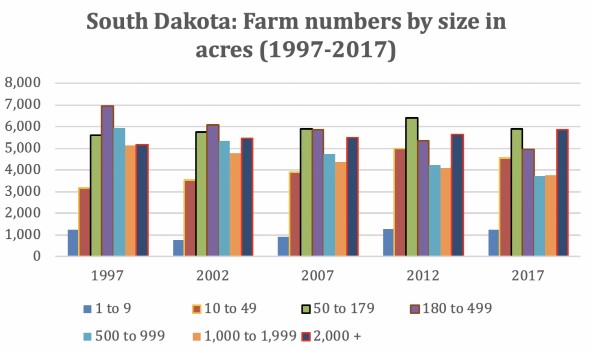By Alvaro Garcia
Agriculture is going through some difficult times not only in the United States, but globally as well. Aside from some short-lived price hikes for different products, the overall trend has been to higher costs of production and lower output prices. Livestock producers oftentimes express their relief with the incredibly low grain prices which, in spite of lower prices for beef they can still make some money out of feeding cattle. For an agricultural system to be long-term sustainable however, every link in the chain needs to get their fair share of the profits. South Dakota is not an exception to this reality and smaller farms are taking the toll.
In 2012, farmers and ranchers in the state sold more than $10 billion worth of agricultural products. That’s was a hard to believe 55 percent increase in just five years. More than 5 million acres of the state’s farmland were planted to corn in 2012, placing the state as the sixth largest corn acreage in the U.S. With a total of 4.7 and 2.2 million acres of soybean and wheat, South Dakota ended in 2012 in the top 10 states for both crops. In fact, in 2014, the state ranked fourth in the country for “all wheat” with 131.26 million bushels up 53.70 million bushels from 2013, a 69% growth! South Dakota growers produced also more than 4.5 million bushels of oats, ranking the state fourth in the nation. In 2012, the state also produced 5.8 million bushels of sorghum, placing the state also in the top 10 for this crop. With a strong livestock sector the state is also among the top 10 with 3.9 million head of cattle and calves. This happened in a year where the U.S. was hit by a drought! Based on these previous statistics, South Dakota was labeled at the time the “New Agriculture Powerhouse.” Fast forward to 2017: the total value of agricultural products sold in 2017 was 9.7 billion dollars, down 4 percent from 2012. Average net income per farm was 81,763 dollars, down 20 percent from 2012. The number of farms in South Dakota during 2017 was 29,968, down 6 percent from the 2012 Census of Agriculture.
What’s Happening?

In the 2017 census the USDA published some strikingly good news for the U.S. overall. The number of farms, particularly small farms, is increasing in the country, reversing a decades-long trend. The census showed a sizable jump in the total number of farms at 4 percent more than in 2002. It also found an increase in the number of “micro-farms” or those with sales of less than $1,000 also increased in the U.S. (580,000 to 700,000). Farms that small are mainly not commercial enterprises, but they typically just feed their owners. This is the only group of the so-called “smaller farms” that has at least remained stable in South Dakota; the reason being they do not rely on their sales to survive. With the exception of the very large group (2000 + acres) all other farms have been declining in the state. Small highly diversified farms in South Dakota are important since they would mean more locally produced food and less gasoline used in its transportation across the state. A recent Cornell University concluded that radical reduction in transport distances saves greater amounts of fuel and also emissions. According to University of California (Berkeley) small farms sequester carbon in the soil more effectively than large farms reducing the amount of carbon in the atmosphere. The 2017 census also showed that while the number of small farms in the U.S. is increasing, food production is concentrating.
The sector with the largest growth in percentage and absolute terms in the U.S. overall were farms with less than 50 acres. This sector, together with the next one (50-179 acres) are the ones that have seen the largest decrease/inflexion point between 2012 and 2017 in South Dakota. The reason for this can be summarized in two words “decreased competitiveness”. It is difficult to predict what to expect for 2019. One thing is certain though, it is going to be another tough year unless global markets for U.S. products expand.